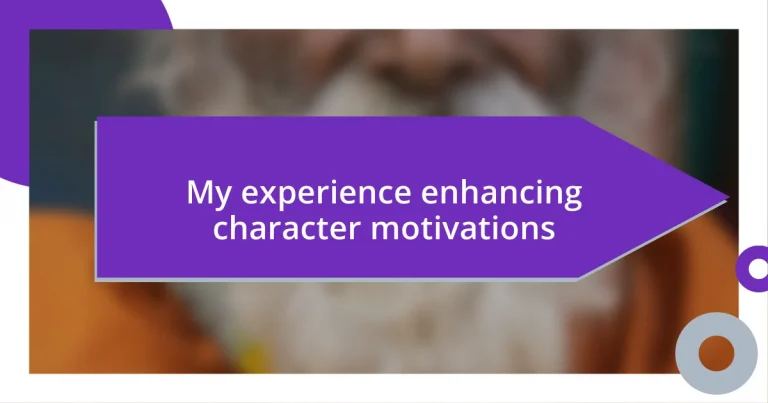Key takeaways:
- Understanding character motivations adds emotional depth and relatability, enhancing the overall storytelling experience.
- Incorporating backstory and conflict is essential for creating compelling motivations and driving character growth throughout the narrative.
- Testing motivations through writing techniques, such as journaling from a character’s perspective, can reveal personal insights and deepen the connection to the character’s journey.
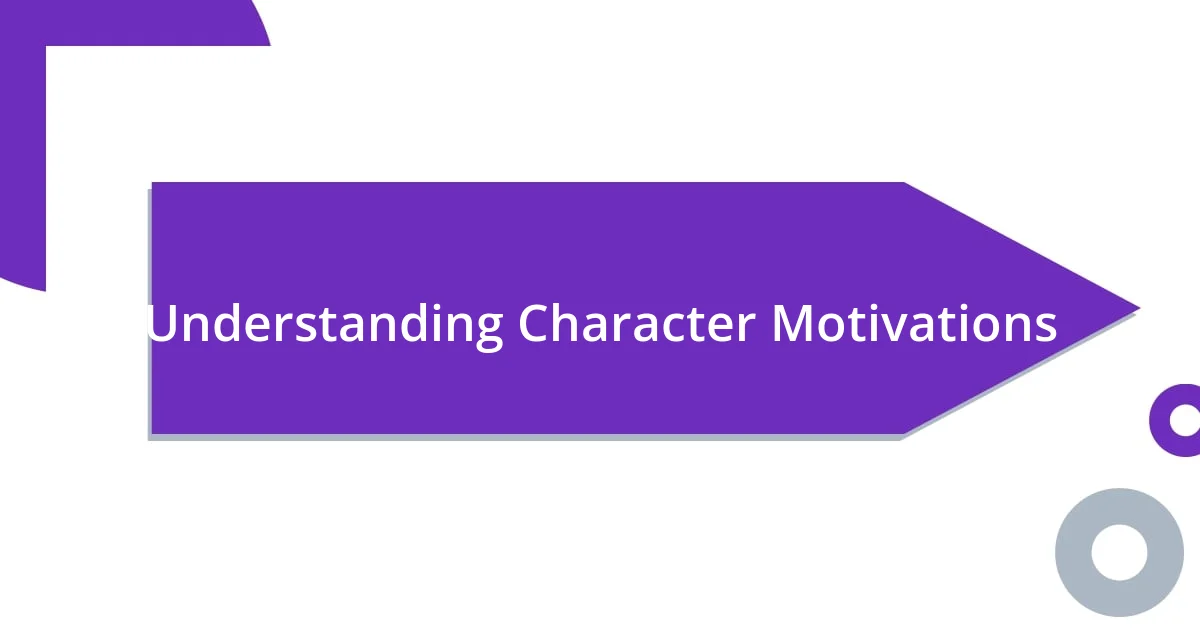
Understanding Character Motivations
Character motivations are the driving forces behind their actions, and understanding these motivations adds layers to storytelling. I remember a character I created who was obsessed with revenge after losing a loved one. This fixation not only shaped their decisions but also drew out emotions in readers as they questioned whether vengeance could truly heal their pain.
Have you ever found yourself rooting for a character, only to realize their motivations stem from deep-seated fears or insecurities? I’ve encountered this many times while reading, where a seemingly antagonistic character becomes relatable once I uncover their backstory. It’s a reminder that motivations are often complex and multifaceted, reflecting universal human experiences.
In my own writing, I strive to ensure each character’s motivation is distinct yet relatable. For example, a character driven by a desire for acceptance reminded me of my own struggles with self-worth during my teenage years. This connection not only made the character’s journey compelling but also offered readers a glimpse into the truths we sometimes hide, enriching the narrative in ways that resonate long after the last page is turned.
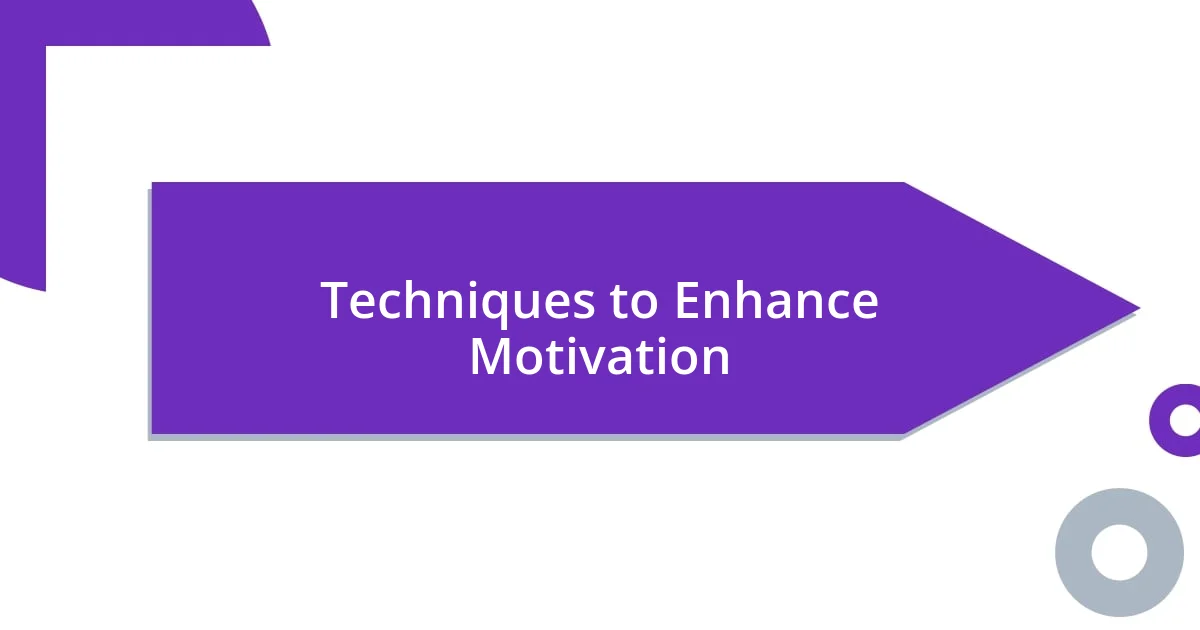
Techniques to Enhance Motivation
To enhance motivation in characters, I find it helpful to incorporate relatable goals that speak to universal desires. When I was developing a character whose ambition was to succeed against all odds, I drew inspiration from my own journey of setting a challenging goal. It became clear that adding obstacles—not just physical but emotional—made their motivation more palpable and engaging for readers.
Here are some techniques that can help create compelling character motivations:
- Establish Clear Goals: Define what the character wants and why. This clarity fuels the narrative and keeps readers engaged.
- Introduce Internal Conflict: Highlight conflicting desires or fears. I once created a character torn between love and duty, making their choices more impactful.
- Use Relatable Emotions: Emotions like fear, joy, or sadness can resonate deeply. I remember writing a moment of failure for a character, which reminded me of my own setbacks—an experience that can draw readers in.
- Incorporate Backstory: A character’s past can provide insight into their motivations. For instance, knowing a character faced betrayal can explain their trust issues, making them more relatable.
- Show Growth: Allow characters to evolve. Witnessing their progression from doubt to determination mirrors personal growth, which many readers will connect with.

Analyzing Character Arcs Effectively
The effective analysis of character arcs is pivotal in storytelling as it reveals how characters evolve over time. I often find myself reflecting on my favorite stories and how character transformations not only propel the plot forward but also resonate deeply with readers. A character who starts out insecure and grows into a confident leader can reflect personal growth in the audience, making their journey feel both authentic and inspiring.
When I analyze character arcs, I tend to look for pivotal moments that serve as catalysts for change. For instance, I once wrote a character who faced a profound loss that shifted their outlook on life. It was fascinating to explore how that single event influenced their actions and relationships throughout the narrative. This aspect of character arcs can deepen the reader’s connection to the story, as they witness characters confronting challenges that mirror real-life struggles.
To understand a character’s arc effectively, I recommend mapping out their journey from a starting point to a transformative outcome. I often create a visual chart to help me visualize these changes. Including details about their motivations, conflicts, and resolutions clarifies their growth trajectory. It’s like piecing together a puzzle that forms a complete picture of a character’s internal landscape.
| Character Arc Element | Description |
|---|---|
| Beginning | Introduce the character’s initial state, including their motivations and flaws. |
| Pivotal Moment | A significant event that challenges the character and sparks change. |
| Growth | Show how the character evolves, integrating the lessons learned from their journey. |
| Resolution | Conclude with the character’s new outlook, demonstrating their transformation. |
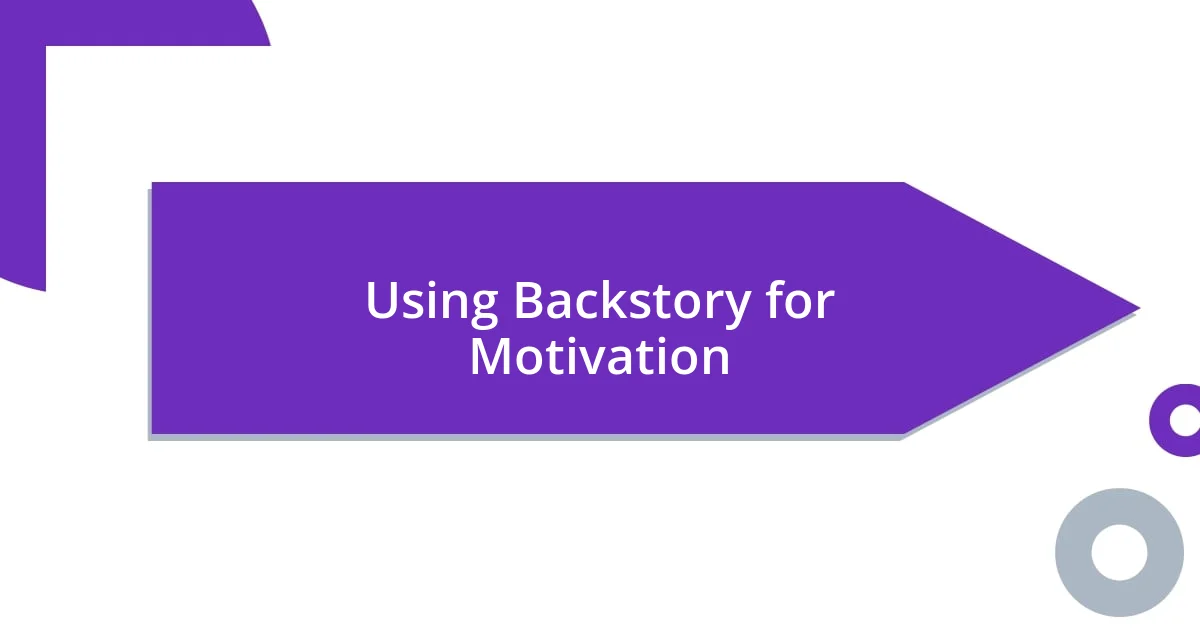
Using Backstory for Motivation
In my experience, backstory is a powerful tool for motivation. I remember developing a character who had grown up in a harsh environment, which shaped their relentless determination to succeed. This past not only fueled their ambition but also created a layer of complexity that made them relatable and compelling. Why do I think this is important? Because readers often connect more deeply with characters whose motivations stem from tangible experiences, rather than just abstract desires.
Backstory also allows writers to explore emotional depth. For instance, I once crafted a character haunted by a childhood betrayal. This history made them wary of forming close relationships, and their struggle to overcome this fear drove much of their character development. Seeing how their backstory influenced their current decisions brought a richness to the narrative that I think readers appreciate. Have you ever noticed how a character’s past can resonate with your own experiences? That’s the magic of a well-constructed backstory.
Additionally, weaving in backstory can create stakes that are personal and compelling. I had a character who was motivated by a promise made to a deceased loved one. This connection not only solidified their drive but also tugged at the reader’s heartstrings, making the stakes feel intensely real. When we tie a character’s motivation to their history, it transforms their journey into something personally meaningful, prompting readers to root for their success and growth. Isn’t it fascinating how our past experiences shape who we become?
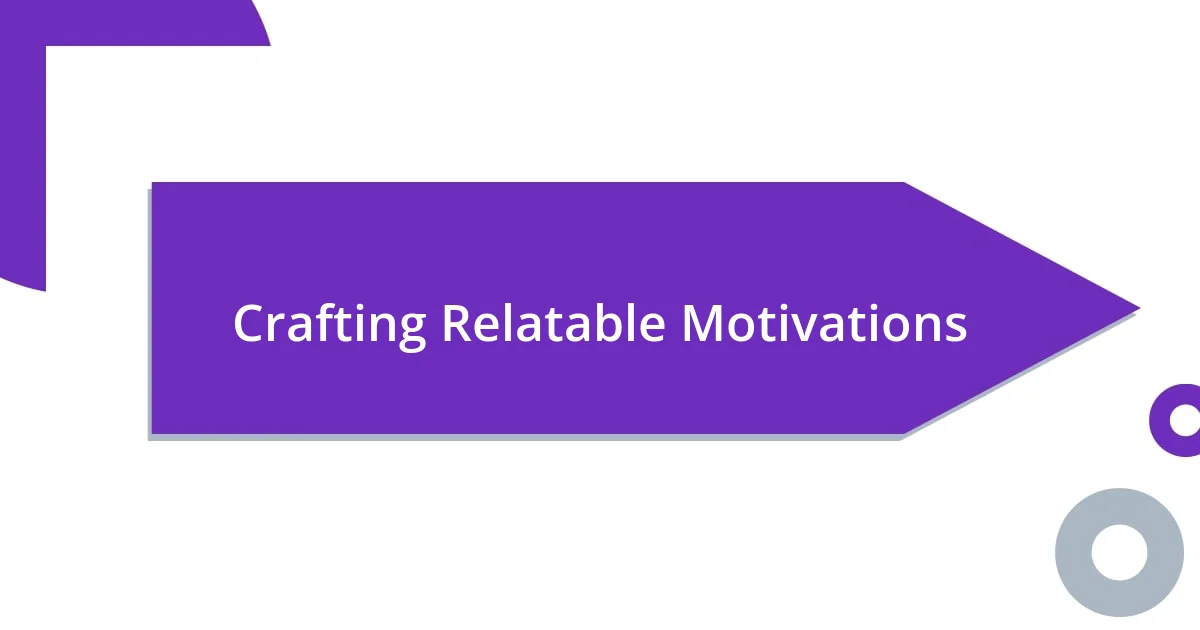
Crafting Relatable Motivations
Crafting relatable motivations is all about understanding the deeper emotional landscape of your characters. I recall a time when I wrote a protagonist driven by a desire for acceptance after years of feeling like an outsider. This motivation wasn’t just a plot device—it resonated with my own experiences of seeking belonging at different stages of my life. Readers often connect better with characters whose motivations mirror familiar feelings or situations, don’t you think?
What I find fascinating is that motivations can be layered. Take, for example, a character who pursues a specific career not only for success but also to honor a parent’s legacy. I once developed a character with this dual motivation, and I could feel the depth it added to their journey. Layering these motivations makes them feel more authentic, as we all juggle multiple desires and fears. Have you ever found yourself driven by more than one thing?
Moreover, I believe that motivations tied to universal themes—like love, loss, or ambition—tend to stick with readers. I created a character who was striving to overcome their family’s expectations to follow their true passion. It was eye-opening to see how many people shared similar struggles in their lives. By tapping into these universal experiences, we invite readers into a shared emotional space, enriching their connection to the story. Isn’t it remarkable how a well-crafted motivation can breathe life into a narrative?
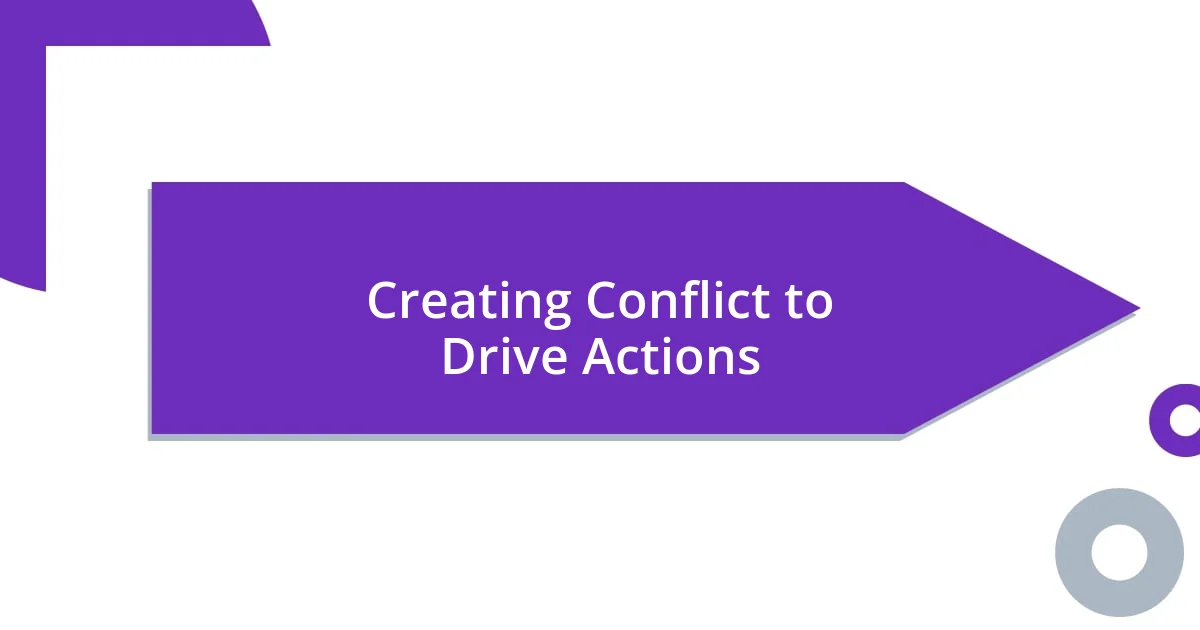
Creating Conflict to Drive Actions
Creating conflict is essential for driving actions in storytelling. It’s that tension between characters’ desires and their circumstances that propels them forward. In one of my stories, I introduced a character whose passion for music clashed with their parents’ expectations to pursue a more traditional career. This inner turmoil not only made their struggle palpable but also pushed them into a series of decisions that shaped their journey. I find that conflict often reveals our true selves—don’t you feel a little more alive when faced with tough choices?
I also discovered that external conflicts can serve as catalysts for character growth. I had a character who was faced with a serious threat—losing their job due to a company merger. This situation forced them to confront their fears, leading to unexpected bravery and resilience. Watching their transformation as they fought for their place was both exhilarating and relatable. It made me wonder, how does conflict spark growth in our own lives?
Furthermore, the stakes must feel personal for the conflict to resonate deeply. In my experience, when I penned a character dealing with a moral dilemma, the choices they had to make weren’t just pivotal for the plot; they were reflections of their deepest values. Readers can sense when a character’s decisions carry significant weight, creating an emotional investment in their journey. Isn’t it powerful how conflict can not only drive actions but also make us reflect on our beliefs and choices?

Testing Motivation Through Writing
Testing motivation through writing is a fascinating exercise. I remember sitting down to draft a character whose fear of failure pushed them to achieve greatness. As I explored this fear, I realized that it mirrored my own journey when I pursued my passion for writing. Isn’t it interesting how the act of writing can unearth our own motivations, offering us a clearer understanding of not just our characters, but ourselves as well?
One technique I found especially effective is journaling from my character’s perspective. A few months ago, I tried this with a character grappling with imposter syndrome. Writing in their voice helped me delve deep into their psychology, revealing layers of insecurity and ambition I hadn’t initially considered. By articulating those feelings on the page, I could almost feel the weight of their struggle. Have you ever tried to write from your character’s viewpoint? It can turn your understanding of their motivation into something profoundly personal.
Through this exploration, I’ve realized that testing motivations by free-writing scenes can spark unexpected insights. For instance, when I drafted a scene where my character faced a pivotal career decision, I was surprised to uncover their conflicting desires for security and adventure. This duality not only enriched their narrative but also prompted me to reflect on my own choices in life. How many times have you felt pulled in different directions? Writing, in this case, became a mirror, revealing the complexities of motivation and desire that reside both in and out of our stories.












